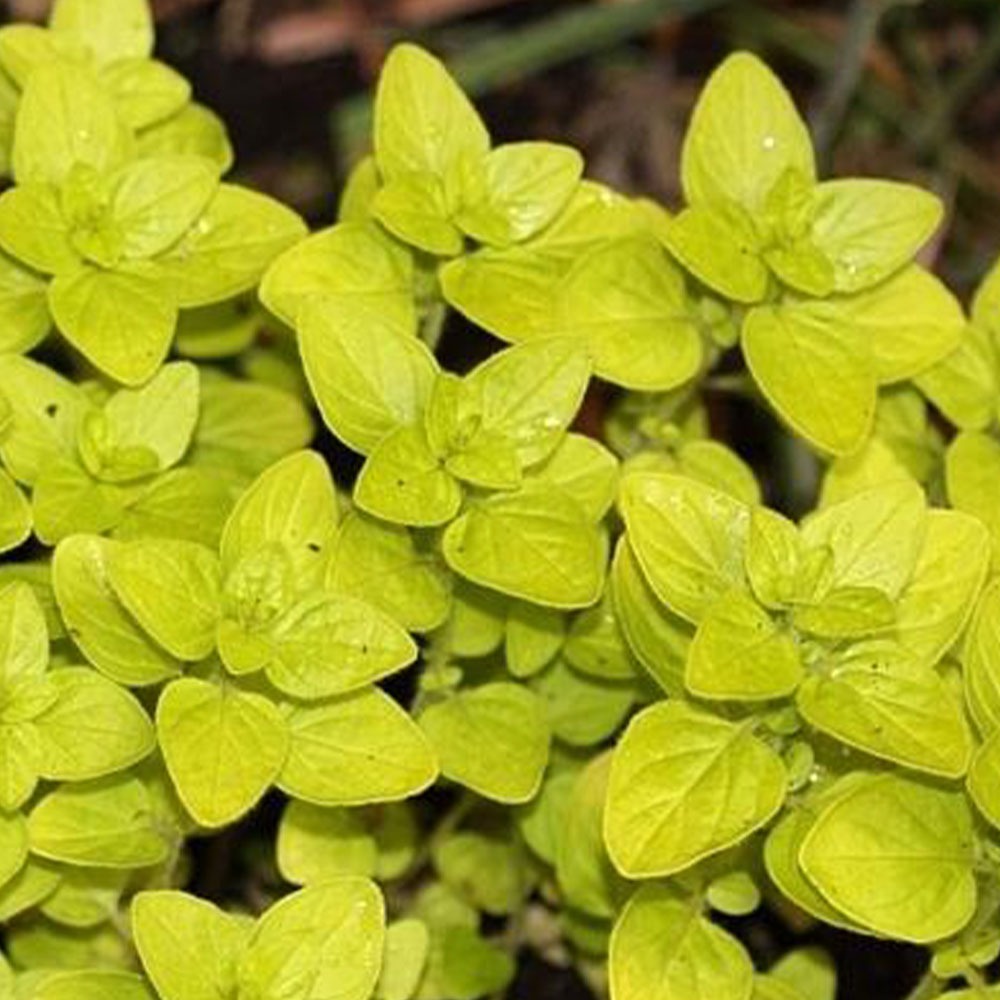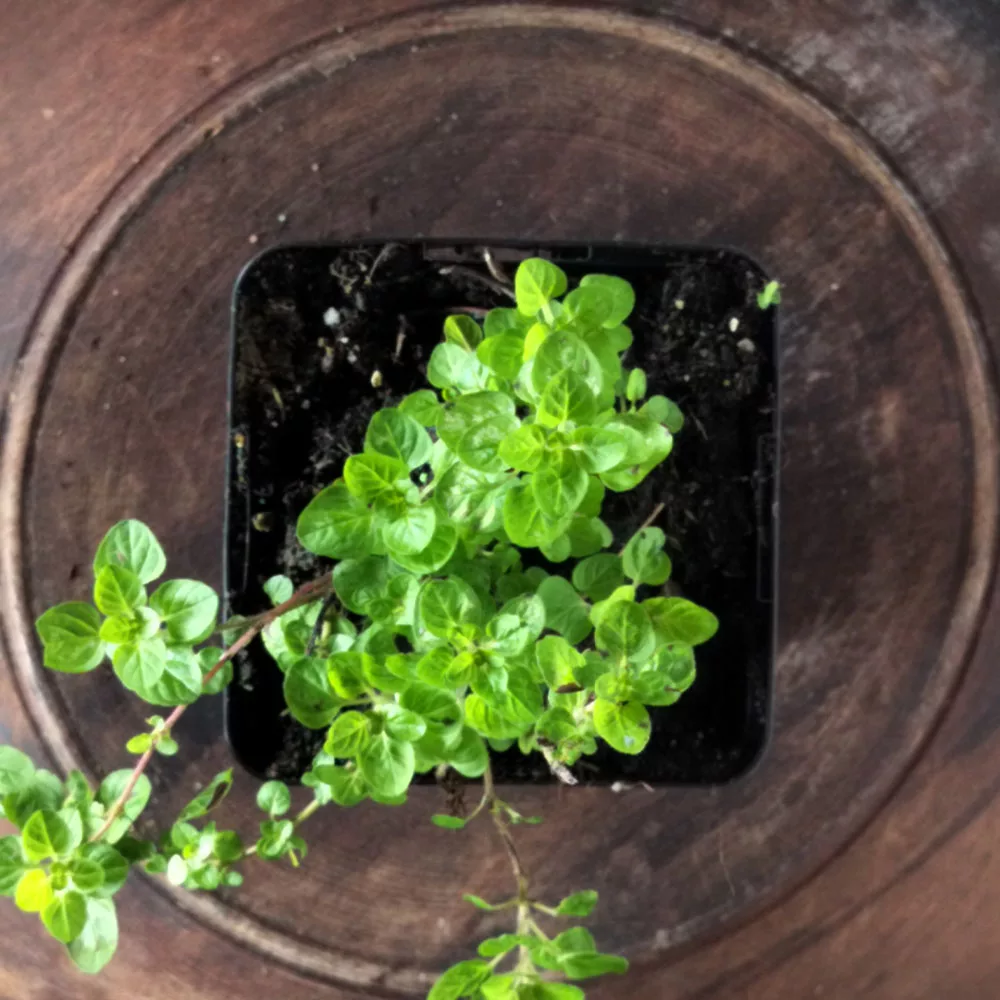No products in the cart.
Origanum vulgare Thumbles Variety
A dense cushion of golden leaves that transition to a light green hue in summer
Rated 0 out of 5
0 customer reviews
4,90 €
Only 24 item(s) left in stock!
Tags: aromatique, comestible, feuillage persistant, perennial, persistant
SKU: pda287
Category: Bees and Butterflies, Balcony-Friendly, Culinary, Distillations, Fragrant, Frost Hardy, Ground Cover, Medicinal

Origanum vulgare Thumbles Variety
4,90 €
Only 24 item(s) left in stock!
Origanum vulgare ‘Thumbles Variety’ is a culinary perennial herb that forms a dense cushion of golden leaves that slowly turn light green in the summer.
In spring, its leaves emerge in a vivid yellow hue that gradually softens to light green in summer, creating a luminous groundcover effect.
The plant produces small, soft pink to purple flowers in summer, which are highly attractive to bees and butterflies.
This variety spreads gently through creeping stems that root as they touch the soil, forming low mats ideal for borders, rock gardens, and containers.
Check out our pre-planted garden boxes, the Jardin Autonome if you’re curious about having aromatic plants inside but fear that watering them is not your strong suit!
👨🌾GARDENING TIPS👨🌾:
-
- As a perennial herb, it will generally die back in the winter but will return in the spring. The foliage may turn brown or shrivel up as temperatures drop, but the plant’s root system remains alive underground, allowing it to regenerate when warmer weather returns. In colder climates, it may lose all its leaves, while in milder areas, it might retain some greenery.
- Prune the plant in late fall or early spring to encourage healthy growth when the growing season resumes.
Learn more about gardening with Oregano:
Learn more about cooking with Oregano (from the wonderful Everyday French chef, Meg Bortin) :
The Tales & The Botany: Origanum vulgare Thumbles Variety
Origanum comes from Greek “oros” (mountain) and “ganos” (joy), literally “joy of the mountain.”
In antiquity, oregano symbolized happiness and was used in bridal wreaths in Greek and Roman traditions.
The wild species, better known as Marjoram, is a fast-growing bushy perennial.
It belongs to the family of mints and sages and is commonly found in the mountainous regions of the Mediterranean Basin and temperate Asia.
As a culinary herb, Oregano evokes Mediterranean cuisine – from fresh tomato sauces to omelets, poultry, fish, vegetables… Everything really!
This variety is particularly well-known in Italy for enhancing pasta, tomato sauces, and pizzas.
Just to add an Ancient Egyptian note: Oregano was used in preparations for embalming the dead.
Like other oreganos, it is hermaphroditic and pollinated by insects, with flowers giving way to tiny nutlet fruits.
🌸 Floral Morphology : Origanum vulgare Thumbles Variety
Oregano (Origanum vulgare) belongs to the Lamiaceae family. This is the Mint Family – full of Menthe Chartreuse, Menthe suaveolens Calixte, Monarda didyma – as are the Lavenders!
Its flowers are bilabiate (two-lipped), small, and arranged in dense, terminal spike-like clusters.
Petals are typically pink to purple, sometimes white, and fused into a short corolla tube. Sepals are persistent, often tinged reddish-purple, giving the inflorescence a colorful, papery bract-like appearance.
Leaves are opposite, ovate, and aromatic, covered in glandular trichomes that secrete essential oils responsible for the pungent, resinous scent.
🍃 Reproductive Biology
Flowers are hermaphroditic, containing both stamens and pistils, and are highly attractive to bees and pollinators thanks to their nectar.
Cross-pollination by insects is the primary mode, though self-pollination can occur.
Fruits are small, four-parted schizocarps that separate into tiny nutlets, allowing efficient seed dispersal. Oregano also spreads vegetatively by rhizomes, forming expanding mats of growth.
🌍 Ecology & Adaptations
Native to Europe and western Asia, oregano thrives in Mediterranean climates, favoring well-drained soils and full sun. Adaptations include:
-
-
💧 Drought resistance
-
🌞 Sun-loving
-
🍃 Perennial growth habit
-
🦋 Ecological value
-
Other Names:
Oregano
Wild Marjoram
Origin:
France
| Weight | 0,2 kg |
|---|---|
| Flowering | July, August, September |
| Exposure | Full Sun |
| Soil | Dry, Well-Draining |
| Frost Tolerance | -25°C to -30°C |
| Size | 0.3m H x 0.5m W |
Reviews
0
Rated 0 out of 5
0 customer reviews
5
0
4
0
3
0
2
0
1
0
Only logged in customers who have purchased this product may leave a review.
Related Products
Hellebore argutifolius
Winter flowering perennial with marbled blue-green leaves
Winter flowering perennial with marbled blue-green leaves
Rated 0 out of 5
Kalanchoe daigremontiana
A toothy succulent from Madagascar, known as the Mother of Thousands.
A toothy succulent from Madagascar, known as the Mother of Thousands.
Rated 0 out of 5
Erigeron kavinskianus
A daisy-like carpet of flowers
A daisy-like carpet of flowers
Rated 0 out of 5
Euphorbia cyparissias Clarice Howard
A Euphorbia that resembles a soft little cyprus tree
A Euphorbia that resembles a soft little cyprus tree
Rated 0 out of 5
Glechoma hederacea
A sweet smelling ground cover, producing little blue flowers all summer long.
A sweet smelling ground cover, producing little blue flowers all summer long.
Rated 0 out of 5
Melissa officinalis
A perennial plant in the mint family that is adored by bees, royal families and tea drinkers.
A perennial plant in the mint family that is adored by bees, royal families and tea drinkers.
Rated 0 out of 5
Vinca minor
Looping elegance and ability to form a low flowering ground cover
Looping elegance and ability to form a low flowering ground cover
Rated 0 out of 5
Tanacetum densum subsp amani
A shrublet composed of soft, finely divided silvery gray-white leaves.
A shrublet composed of soft, finely divided silvery gray-white leaves.
Rated 0 out of 5
Artemisia Valerie Finnis
A semi-evergreen, aromatic variation on the theme of Artemisia.
A semi-evergreen, aromatic variation on the theme of Artemisia.
Rated 0 out of 5
Sedum album
A low, multi-color ground cover.
A low, multi-color ground cover.
Rated 0 out of 5
Hieracium maculatum Leopard
A native perennial with blue-green leaves and a tall yellow flower
A native perennial with blue-green leaves and a tall yellow flower
Rated 0 out of 5
Cerastium tomentosum var. columnae
A grey-green spreading ground cover from the mountains.
A grey-green spreading ground cover from the mountains.
Rated 0 out of 5
Euphorbia myrsinites
Known for its draping form of silver-gray foliage and radiant blooms.
Known for its draping form of silver-gray foliage and radiant blooms.
Rated 0 out of 5
Trachelospermum asiaticum ‘Ogon Nishiki’
Jasmine with colorful foliage and lovely white flowers in summer
Jasmine with colorful foliage and lovely white flowers in summer
Rated 0 out of 5
Delosperma cooperi
A dwarf perennial known for its vermillion colored flowers
A dwarf perennial known for its vermillion colored flowers
Rated 0 out of 5
Mentha x piperita ‘Chartreuse’
A spicy mint, known for its use in the production of liqueurs and herbal teas.
A spicy mint, known for its use in the production of liqueurs and herbal teas.
Rated 0 out of 5
Echinacea purpurea
A perennial with purple flowers all summer long
A perennial with purple flowers all summer long
Rated 0 out of 5
Stachys byzantina
Silky white-grey leaves and tall striking flowers
Silky white-grey leaves and tall striking flowers
Rated 0 out of 5
recent view product
Chrysanthemum Dernier Soleil
A perennial with large yellow flowers tipped with coppery-orange hues
A perennial with large yellow flowers tipped with coppery-orange hues
Rated 0 out of 5
Linum perenne
A perennial flax that produces bouquets of ephemeral, beautiful sky-blue flowers throughout the summer
A perennial flax that produces bouquets of ephemeral, beautiful sky-blue flowers throughout the summer
Rated 0 out of 5
Thymus camphoratus
An upright shrub with white velvet leaves and an aroma of camphor and summer.
An upright shrub with white velvet leaves and an aroma of camphor and summer.
Rated 0 out of 5
Tradescantia Blushing Bride
Gorgeous blushes of pink and white that appear in the coldest nights.
Gorgeous blushes of pink and white that appear in the coldest nights.
Rated 0 out of 5
Helichrysum italicum
An evergrey, fragrant perennial that will bring a distinctly Mediterranean atmosphere.
An evergrey, fragrant perennial that will bring a distinctly Mediterranean atmosphere.
Rated 0 out of 5



















































There are no reviews yet.